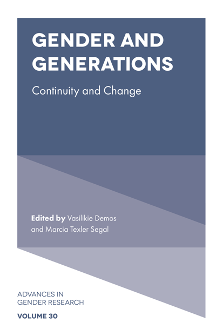
Index
Gender and Generations: Continuity and Change
ISBN: 978-1-80071-033-7, eISBN: 978-1-80071-032-0
ISSN: 1529-2126
Publication date: 15 March 2021
Citation
(2021), "Index", Demos, V. and Segal, M.T. (Ed.) Gender and Generations: Continuity and Change (Advances in Gender Research, Vol. 30), Emerald Publishing Limited, Leeds, pp. 173-176. https://doi.org/10.1108/S1529-212620210000030011
Publisher
:Emerald Publishing Limited
Copyright © 2021 Emerald Publishing Limited
INDEX
Note: Page numbers followed by “n” indicate notes.
- Prelims
- Gender and Generations: An Introduction
- Chapter 1: Gender and Generation in Thinking with Patriarchy
- Chapter 2: Upward and Outward Mobility: Women’s Aspirations for Their Daughters in Urban India
- Chapter 3: Intergenerational Transmission of Gendered Attitudes Among Second-Generation Adolescents: The Role Culture Plays in Modifying the Transmission of Gender Ideology from Immigrant Mothers to Their Children
- Chapter 4: Convergence or Divergence? The Generational Gap in Gender Attitudes, 1977–2018
- Chapter 5: Gender and Generation: Focus on Women Baby Boomers’ Approaches to Retirement
- Chapter 6: Gender, Sexual Orientation and Life Course Perspectives on LGBTQ Status
- Chapter 7: Modeling Types of Informal Care Dyads by Gender, Primary Condition, and Relative Age
- Chapter 8: Paid Caregiving: An Extension of Women’s Work
- Index